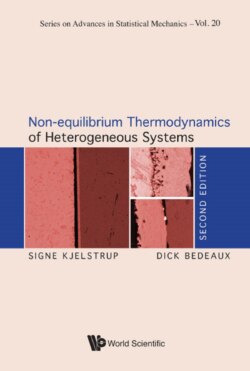Читать книгу Non-equilibrium Thermodynamics of Heterogeneous Systems - Signe Kjelstrup - Страница 15
2.4Entropy production, work and lost work
ОглавлениеNon-equilibrium thermodynamics is probably the only method that can be used to assess how energy resources are exploited within a system. This is because the theory deals with energy conversion on the local level in a system, i.e. at the electrode surface [84] or in a biological membrane [55]. By integration to the system level, we obtain a link to exergy analysis [85]. To see the relation between non-equilibrium thermodynamics and exergy analysis, consider again the thermodynamic fluxes and forces, derived from the local entropy production
| (2.9) |
Figure 2.1A schematic illustration of thermodynamic variables that are essential for the lost work in an industrial plant.
The total entropy production is the integral of σ over the volume V of the system
| (2.10) |
The quantity dSirr/dt makes it possible to calculate the energy dissipated as heat or the lost work in a system (see below).
In an industrial plant, the materials undergo certain transformations in a time interval dt. Materials are taken in and are leaving the plant at the conditions of the environment. The environment is a natural choice as frame of reference for the analysis. It has constant pressure p0 (1 bar) and constant temperature T0 (for instance, 298 K) and some average composition that needs to be defined. The first law of thermodynamics gives the energy change of the process per unit of time:
| (2.11) |
Here, dQ/dt is the rate that heat is delivered to the materials, p0dV/dt is the work that the system does per unit of time by volume expansion against the pressure of the environment, and dW/dt is the work done on the materials per unit of time.
The minimum work needed to perform a process is the least amount of energy that must be supplied when, at the conclusion of the process, the only systems which have undergone any change are the process materials [86]. To see this, we replace dQ/dt by minus the heat delivered to the environment per unit of time, dQ/dt= −dQ0/dt:
| (2.12) |
The second law gives
| (2.13) |
where dS/dt is the rate of entropy change of the process materials and dS0/dt is the rate of entropy change in the environment. For a completely reversible process, the sum of these entropy rate changes is zero. For a non-equilibrium process, the sum is the total entropy production, dSirr/dt,
| (2.14) |
The entropy change in the surroundings is dS0/dt = (dQ0/dt)/T0. By introducing dQ0/dt into the expression for the entropy production, and combining the result with the first law, we obtain, after some rearrangement,
| (2.15) |
The left-hand side of this equation is the work that is needed to accomplish the process with a particular value of the entropy production, dSirr/dt. Since dSirr/dt ≥ 0, the ideal (reversible) work requirement of this process is
| (2.16) |
We see that dS/dt changes the ideal work. By comparing Eqs. (2.15) and (2.16), we see that T0(dSirr/dt) is the additional quantity of work per unit of time that must be used in the actual process compared to the work in an ideal (reversible) process. Thus, T0(dSirr/dt) is the wasted or lost work per unit of time:
| (2.17) |
The lost work is the energy dissipated as heat. The relation is called the Gouy–Stodola theorem [87, 88]. The right-hand side of Eq. (2.16) is also called the time rate of change of the availability or the exergy [65, 85]. We shall learn how to derive σ in subsequent chapters. One aim of the process operator or designer should be to minimize dWlost/dt [89], which is equivalent to entropy production minimization, see [88, p. 227; 32, Chapter 6]. Knowledge about the sources of entropy production is central for our work to improve the energy efficiency of processes. In a recent book Non-equilibrium Thermodynamics for Engineers [2, 3], we discussed how irreversible thermodynamics can be used to map the lost work in an industrial process. The aluminium electrolysis was used as an example to illustrate the importance of such a mapping. Furthermore, the first steps in a systematic method for the minimization of entropy production were described, with its basis in non-equilibrium thermodynamics. Second law optimization [88, 90–95] in mechanical and chemical engineering may become increasingly important in the design of systems that waste less work. Non-equilibrium thermodynamics will play a unique role in this context. For details on how to map the second law efficiency of an industrial system or how to systematically improve this efficiency, we refer to Bejan [87, 88] and to the book Non-equilibrium Thermodynamics for Engineers [2, 3].
